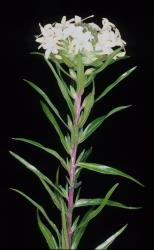- Taxon
- Gallery
Annual, branched or not, to c. 50 cm tall; stems often purplish, with short downward curled, white hairs, these dense towards the apex. Lvs apetiolate, 300–100 × 3–12 mm, usually entire, occasionally remotely toothed, linear or linear-lanceolate, glandular-hairy and viscid, later glabrous except for ciliolate margins. Infl. terminal, capitate, with subsessile fls, also with solitary axillary fls beneath on pedicels to c. 3 cm long. Bracts lanceolate to ovate, acuminate, often > infl., with very viscid glandular hairs. Calyx 9–12 mm long, lobed to c. 1/2 way, glandular-hairy and viscid; tube membranous; lobes lanceolate or narrow-lanceolate, almost = tube. Corolla c. 2–2.5 cm long, mostly creamy yellow at first, soon becoming pale salmon pink, rarely becoming mauve-pink; tube > calyx; lobes c. 8 mm long, elliptic, ± acute. Stamens exserted from tube; anthers blue. Capsule c. 5 mm long. Seed 2.5–3.5 mm long, obovoid, finely pitted, glabrous or puberulent.
[From: Webb et al. (1988) Flora of New Zealand. Volume 4. as Collomia cavanillesii Hook. & Arn.]
Flowering: Nov.–Apr.




